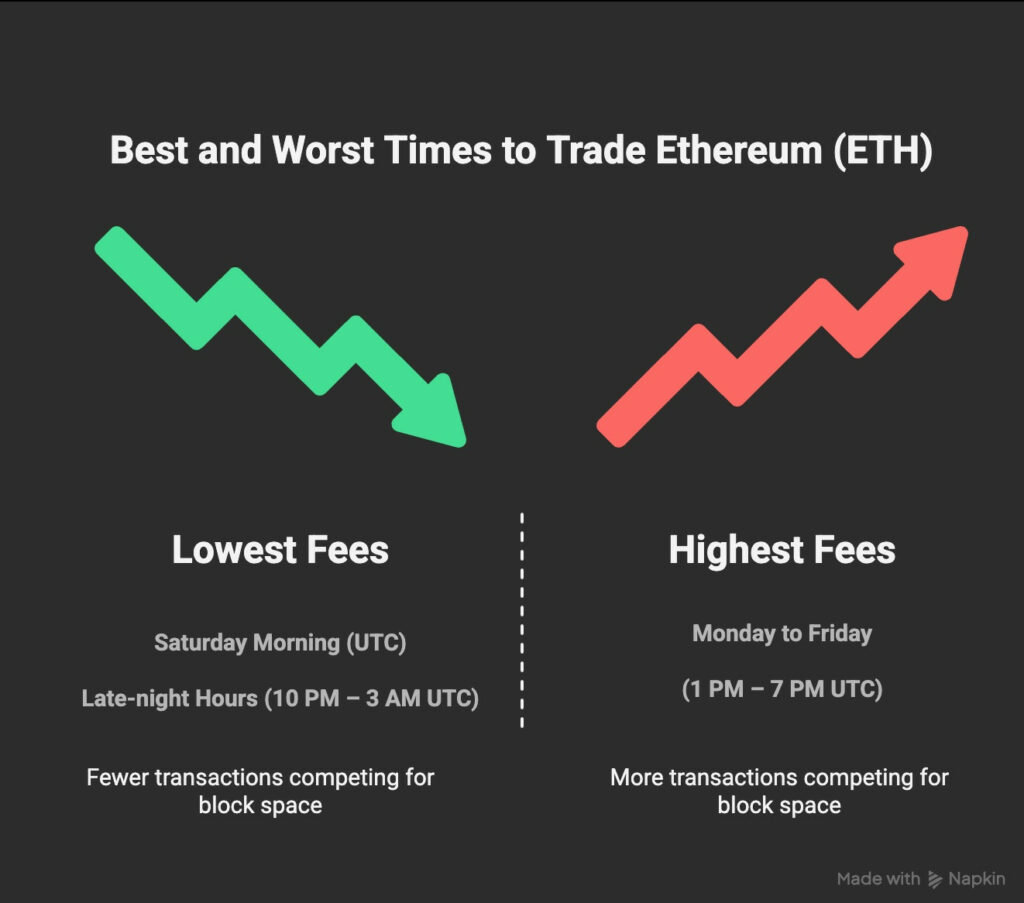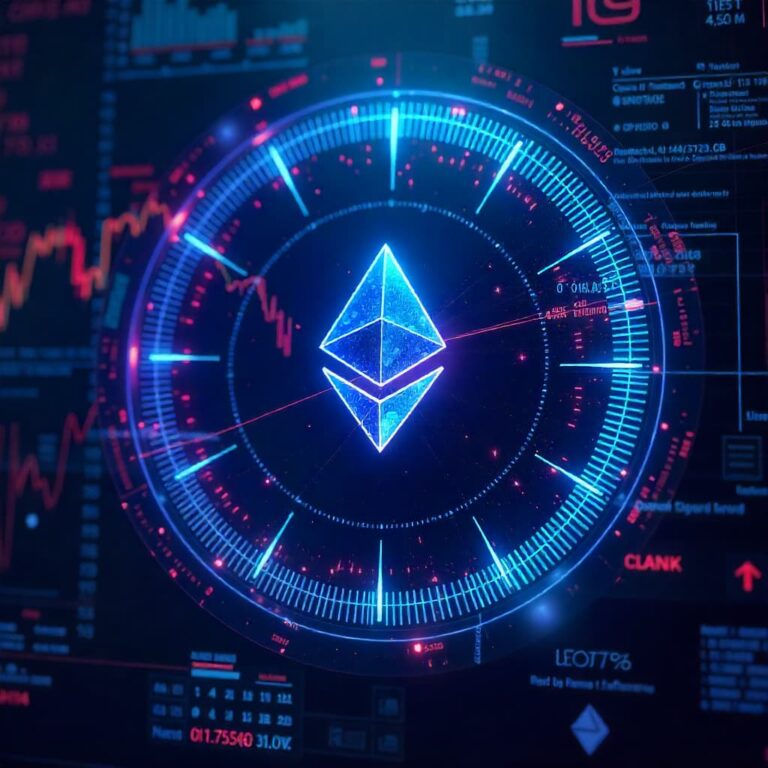This guide is part of the “Guide to ETH Gas Fees” series.
Want to avoid high ETH fees?
If you’ve ever tried to send Ethereum during a busy period, you’ve probably had that gloomy feeling when the transaction fee pops up, and it’s higher than the amount you’re actually sending. You may think gas prices for Ethereum are unpredictable, but that’s only at first glance, in reality, they follow patterns. Once you understand these patterns, you can make your transactions when the network is quiet and pay only a fraction of the cost.
The good news is you don’t need to be a coder or a market analyst to do this. You just need to know when the blockchain’s busiest “traffic jams” happen and when the road is clear. This quick guide breaks it all down for you, saving you time and money.
Table of Contents
When are Ethereum fees cheapest?
At the heart of it, the single biggest factor driving price fluctuations is how many people are competing to get their transactions processed at the same time. The more crowded the network, the more each sender has to bid to get priority. When the network is quiet, validators don’t need to be “bribed” with higher tips, and so your costs drop sharply.
The trick is learning these quiet periods and planning your transactions to fit them.
The weekend advantage
Saturday and Sunday are often the cheapest time to use Ethereum, and it’s not just a coincidence. A huge portion of Ethereum’s heavy traffic comes from institutional players, large trading desks, and automated arbitrage systems that operate during the week. When traditional markets in North America and Europe close for the weekend, the number of large, high-priority transactions drops noticeably.
DeFi activity also takes a breather. Many protocols still operate 24/7, but human traders, corporate treasuries, and market-making bots linked to fiat settlement slow down. That means fewer high-bid transactions competing for the same block space.
If you’ve got a non-urgent transaction, like moving funds between wallets, approving tokens for a dApp, or making a casual NFT purchase, doing it on Saturday morning UTC is often dramatically cheaper than on Wednesday afternoon.
Night owl discounts
If your schedule doesn’t allow for you to wait over the weekends, you can still find cheap gas prices by aiming for late-night hours (specifically between 10 PM and 3 AM UTC).
Here’s why:
- The US trading day is over, and most high-volume activity on centralized exchanges has slowed.
- European markets have been closed for hours, so their DeFi trading and institutional flows are quiet.
- The Asia-Pacific region hasn’t fully opened up yet, so the surge of morning activity in markets like Hong Kong, Singapore, and Seoul hasn’t started yet.
It’s one of the rare daily windows when all three major crypto regions are simultaneously off-peak.
How to tell if you’re in a low-fee period
While weekends and late nights UTC are reliable averages, they’re not guaranteed. An NFT drop, or a token launch, or a sudden spike in ETH volatility can spike gas prices in minutes.
That’s why you should always support yourself with real-time tracking if you’re going to be involved with crypto.
A quick check on a live gas tracker, like vTrader’s ETH Gas Tracker, can confirm if fees are actually low before you click “send.” Many people set alerts for when gas drops below a particular price level of Gwei, and after the notification, they roll out their pre-planned trades.
When Ethereum fees tend to be the highest
Timing your transaction wrong can cost you more than just bad market execution. Send ETH during the wrong window and you might end up paying triple the fee you’d pay just a few hours later. The best strategy isn’t just knowing when to transact, it’s also about knowing which times are so expensive that you should completely avoid trading.
Weekday rush hour
From Monday to Friday, the stretch between 1 PM and 7 PM UTC is Ethereum’s equivalent of a freeway rush hour. US markets are opening, European markets are still active, and the overlap creates one of the busiest transaction periods of the week.
This is when you see everything firing at once: traders are rebalancing their portfolios, algorithms are processing big liquidity moves, NFT marketplaces are settling bids, and automated bots are competing for the fastest block inclusion. In this environment, validators have their pick of high-paying customers, so the average gas price shoots up.
For perspective, a crypto swap that costs $4 on a Sunday morning might spike to $15 during this overlap. The fee hike isn’t because your transaction suddenly became more complex, it’s simply because you’re bidding against more people for the same limited block space.
Market chaos spikes
Even outside of rush hour, the network can get heavy if the market gets volatile. A sudden price drop in ETH or another major token sets off a chain reaction: leveraged traders get liquidated, arbitrage bots scramble to take advantage of mispriced assets, and DeFi users rush to adjust their positions.
All of this creates a bidding war for block space. Gas fees don’t just climb at a time like this, they can explode within a single block. This isn’t limited to market crashes either; sudden price rallies can trigger the same behavior when FOMO buying kicks in.
If you see ETH’s price making sharp moves and your transaction isn’t urgent, it’s usually worth waiting. Many traders will sit out 30–60 minutes, then recheck fees once the action has cooled down. This simple delay can cut your costs in half.

How to track gas prices in real time
General patterns are a good baseline, but Ethereum doesn’t always follow the script. Real-time tracking is essential, it turns your timing from “educated guess” into “informed execution.”
Some tools to help you keep track of gas prices:
- VTrader ETH Gas Tracker – The fastest way to check live Gwei prices and historical trends. Available on vtrader.io and as a mobile app that can send alerts when fees drop into your target range.
- Etherscan Gas Tracker – Shows base fees, priority fees, and estimated confirmation times for different speed settings.
- Gas Now – Provides live readings plus short-term forecasts, where you can see if fees are likely to drop soon.
- Blocknative Gas Estimator – Integrates automatically with certain wallets to recommend optimal fees before you confirm a transaction.
Using these alongside timing patterns gives you the best of both worlds: a reliable idea of when fees tend to be low, and the live confirmation to make sure you’re actually catching those lows in the moment.
Key takeaways
If you want the cheapest ETH transactions, weekends and late-night UTC windows are your best bet. Avoid weekday overlap hours between US and European markets, and always be cautious during volatile market events. Always double-check live gas prices before committing, remember the network can still throw curveballs at you.
The beauty of Ethereum is that you can save money just by picking your moment. A transaction that costs a certain amount on a Friday might only cost you only 1/3rd of that if you send it on Saturday morning. Multiply that over dozens of transactions, and the savings add up quickly.
So the next time you’re about to send ETH, check the time, check a tracker, and decide if it’s worth waiting. The network never sleeps, but your fees will take a nap, that’s when you should transact.

Steve Gregory is a lawyer in the United States who specializes in licensing for cryptocurrency companies and products. Steve began his career as an attorney in 2015 but made the switch to working in cryptocurrency full time shortly after joining the original team at Gemini Trust Company, an early cryptocurrency exchange based in New York City. Steve then joined CEX.io and was able to launch their regulated US-based cryptocurrency. Steve then went on to become the CEO at currency.com when he ran for four years and was able to lead currency.com to being fully acquired in 2025.


